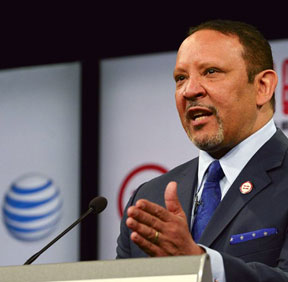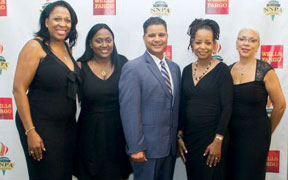
 New Report: Despite progress, deep inequality plagues Black America
New Report: Despite progress, deep inequality plagues Black America
Marc Morial, president and CEO of the National Urban League, speaks during the “2016 State of Black America” launch event at the Newseum in Washington, D.C. (Freddie Allen/AMG/NNPA)
By Stacy M. Brown, NNPA News Wire Contributor
In 1976, then-President Gerald Ford delivered the annual “State of the Union Address,” virtually ignoring the plight of African-Americans and Latinos.
That drove Vernon Jordan, then-president of the National Urban League (NUL), to commission his own report. Now, 40 years later, the “State of Black America” report is a prominent tool that continues to show just where African-Americans, Latinos and other minorities stand in the United States.
NUL President Marc H. Morial said that it’s clear that much needs to be done.
“As we observe the 40th anniversary of the State of Black America, the similarities in the nation in 2016 and that which, then-National Urban League Executive Director Vernon Jordan documented in 1976 are disheartening,” Morial said on Tuesday, May 17, 2016 at the Newseum in Washing-ton, D.C., during the unveiling of the 40th annual report.
“Our nation was struggling to overcome the worst economic downturn since the Great Depression. Pressure was building to slash social services for the poor, who were demonized and characterized as swindlers. Communities were rocked by hostility and violence triggered by legal challenges to the social status quo,” Morial said.
As with every economic downturn, communities of color bore the brunt of the decline, Morial noted. Black Americans remained nearly twice as likely as whites to be unemployed and, since 1976 the Black un-employment rate has consistently remained about twice that of the white rate across time, regardless of educational attainment.
“The household income gap remains at about 60 cents for every dollar. Black Americans are only slightly less likely today to live in poverty than they were in 1976,” he said.
On the criminal justice front, Morial said Jordan, who served as president of the NUL from 1971 to 1981, noted that Blacks were underrepresented in law enforcement in 1976.
“The City of Chicago is an example: with a population that is 32.7 percent Black, it has a police force that is only 16 percent Black,” he said. “Today, in hundreds of police departments across the nation, the percentage of whites on the force is more than 30 percentage points higher than in the communities they serve.”
A moving video accompanied Morial’s speech during the event. It featured Trayvon Martin, Michael Brown, Eric Garner, Freddie Gray, Sandra Bland and others who have lost their lives in police-related incidents.
Morial spoke fervently about how Blacks were once consi-dered by law to be just three-fifths of a human.
“That’s about 60 percent and, if you’re looking for a way to measure how far we’ve come, in 2004 we introduced the equality index and in 2016 that number is 72.2 percent,” he said.
The report’s bottom line is that African-Americans and Latinos continue to fall way behind whites in key economic areas, including household income and unemployment rates.
The State of Black America examined economic data for 70 metro areas for Blacks and 73 for Hispanics and found that there were no regions in the United States where Blacks were more likely to be employed or make more money than whites.
Like Blacks, Hispanics in all regions were consistently paid less than whites though, on average, the gaps between white household income and Hispanic household income were smaller than those between whites and Blacks, the report found.
“This is the remaining issue of civil rights and economic justice in America,” Morial said.
“This economic gap between Blacks and whites, which is a component of the gap between rich and poor and working class people in America is a continuing problem.”
In 2015, nationally 6.6 percent of Hispanics and 9.6 percent of Blacks were unemployed compared with 4.6 percent of whites.
The report revealed that African Americans are doing about the same as they have in previous years as the nation rises out of the Great Recession, which still is surprising better than they did when the first State of Black America report was released in 1976.
The NUL’s equality index is based on collected data from federal agencies including the Census Bureau, the Bureau of Labor Statistics, the National Center for Education Statistics, and the Centers for Disease Control and Prevention.
With full equality with whites in economics, health, education, social justice and civic engagement set at 100 percent, the NUL said this year’s equality index for Blacks stands at 72.2 percent, compared with last year’s 72 percent.
For Hispanics, it’s 77.8 percent compared to last year’s rate of 77.3 percent.
Since 1976, fewer Blacks live in poverty – 29 percent in 1976 compared with 27 percent now. More Blacks have graduated high school and college – 28 percent in 1976 and 33 percent today for high school, and 6 percent four decades ago versus 22 percent today for college.
Life expectancy of African-Americans has increased from 68 in 1976 to 75 today.
Homeownership and voting, however, continue to be major obstacles with 43 percent of African-Americans owning a home compared to the 43.7 percent that owned homes in 1976.
Voting is down considerably as 48.7 percent of African-Americans cast ballots in 1976 compared with just 39.7 percent today.
For the second year in a row, California’s Riverside-San Bernardino-Ontario metroplex is the best for Blacks when it comes to income equality compared to whites.
An African-American worker makes 76 cents to every dollar a white worker makes in those cities, the highest ratio in the nation. For Latinos, Honolulu is the most promising for income equality: Hispanics make 80 cents for every dollar made by whites.
Washington, D.C., and its suburbs are where Blacks, whites and Hispanics have the highest median household income. Whites make $109,460, Hispanics make $66,523, and Blacks make $66,151.
The cities with the lowest Black unemployment rate are Oklahoma City and San Antonio at 8.3 percent. The city with the lowest Hispanic unemployment rate is Tulsa, Okla., with a 4.6 unemployment rate.
Morial has put out the call for a major commitment from the government to rebuild the nation’s urban communities called the “Main Street Marshall Plan.”
He’s seeking one trillion dollars over the next five years committed to several programs including universal early childhood education, homeownership strategies, high-speed broadband and technology, and a $15 per hour federal living wage indexed to inflation.
“While education is crucial, education alone is not going to solve the economic gaps in the country,” Morial said.




Be the first to comment